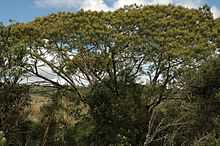Mimosa scabrella
| Mimosa scabrella | |
|---|---|
 | |
| Scientific classification | |
| Kingdom: | Plantae |
| (unranked): | Angiosperms |
| (unranked): | Eudicots |
| (unranked): | Rosids |
| Order: | Fabales |
| Family: | Fabaceae |
| Subfamily: | Mimosoideae |
| Genus: | Mimosa |
| Species: | M. scabrella |
| Binomial name | |
| Mimosa scabrella Benth.[1] | |
| Synonyms | |
| |
Mimosa scabrella is a tree in the Fabaceae family. It is very fast-growing and it can reach a height of 15 m tall in only 3 years.[2] Its trunk is about 0.1–0.5 m in diameter.[3] It has yellow flowers.[4]
Biology
Mimosa scabrella (Bracatinga) is a tree of the Fabaceae family, sub-family Mimosoideae. It is a cross pollinating, mostly tetraploid plant with 52 chromosomes. M. scabrella is native to the southern region of Brazil. There it grows naturally in associations called “Bracatingais”. Especially the Cerrado zone is a centre of biodiversity, where about one quarter of all Mimosa species are found.[5] It is one of the fastest growing trees in the world. Within 14 months Mimosa scabrella grows up to 5 m, in 2 years it reaches 8–9 m and in 3 years it can grow to a height of 15 m. [6]
Characterization
The plant is characterized by quick growth, with a lean trunk of around 10–50 cm in diameter. The leaves are bi-pinnate. Each leaf has several pinna, which again have 15–31 pairs of pinnules. The upper side of the leaves is yellow-green coloured with a paler underneath.
The flowers with ovary, narrow and slender pistils are ordered in clusters of 1–3 at the leaf bases. They are coloured in a whitish to yellow colour. Split-open pods are flattened, 2–4 mm wide and 5–9 mm long. They are covered with tiny warts and separated into 2–4 segments. Each segment is 4-angeled and 1-seeded. The seeds are little, brown, beanlike and about 3–6 mm long. The dominant reproductive system is an allogamy (cross-pollinating) system. The reproductive age of M. scabrella is reached after around 3 years [5] .[6]
Uses
The long fibres can be used for paper production. Because of abundant flowering M. scabrella can be used in honey production. Its wood is suitable for firewood and can also be used as lumber. Before the advent of the diesel locomotive, M. scabrella wood was grown to fuel railroads in parts of Brazil.[3] In agroforestry M. scabrella shades coffee plants. It is also used in intercropping systems in association with maize and beans. Because M. scabrella is a legume tree it doesn't need fertilization and with the decomposition of the leaves, big amounts of nitrogen become available for other plants. Because M. scabrella has beautiful “feather” leaves, it is often used as an ornamental tree or live fence. Because of its fast growth it can be used for reforestation. .[6]
Alkaloids
Mimosa scabrella contains tryptamine, N-methyltryptamine, N,N-dimethyltryptamine and N-methyltetrahydrocarboline in its bark.[7]
Cultivation
Mimosa scabrella can be grown at altitudes between 200 to 2400 m with an annual mean temperature between 12 and 23 °C. The annual precipitation should reach from 600 to 3500 mm. The soil should be well drained. Acid soils with pH as low as 4.8 and soils with high aluminium content are tolerated. Waterlogged, compacted or severely degraded soils are not suitable for M. scabrella. Dry periods of up to four moths can be tolerated. Mimosa scabrella is suceptible to strong winds.
Although M. scabrella is native to Brazil, it’s cultivated in many South American, some African and South European countries. In its native range, some 28 species of insects are reported to attack M. scabrella. .[6]
See also
- Psychedelic plants
- Reforestation
References
- ↑ "Mimosa scabrella information from NPGS/GRIN". www.ars-grin.gov. Retrieved 2008-04-19.
- ↑ "Mimosa scabrella". www.hort.purdue.edu. Retrieved 2008-04-19.
- ↑ 3.0 3.1 "Species Information". www.worldagroforestrycentre.org. Retrieved 2008-04-27.
- ↑ "SysTax - detailed information on Mimosa scabrella Benth.". www.biologie.uni-ulm.de. Retrieved 2008-05-05.
- ↑ 5.0 5.1 Dahmer N, Schifino-Wittmann M T, Guerra D, Weiler R L. (2013) ‘‘Bracatinga’’ (Mimosa scabrella Bentham), a multipurpose tree growing in Southern Brazil: chromosome number and genetic variation. Genet Resour Crop Evol 60:377–383 http://link.springer.com/article/10.1007/s10722-012-9931-6#page-1
- ↑ 6.0 6.1 6.2 6.3 Orwa C,A Muta, Kindt R, Jamnads R,S Anthony. 209 Agroforestry Database: a tree reference and selection guide version 4.0 (http://www.worldagroforestry.org/treedb/AFTPDFS/Mimosa_scabrella.pdf) http://www.worldagroforestry.org/treedb/AFTPDFS/Mimosa_scabrella.pdf
- ↑ Google Book Search. books.google.com. Retrieved 2008-05-07.